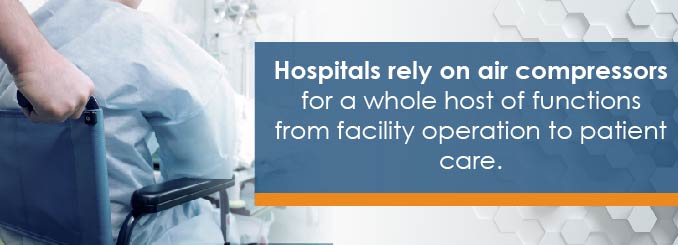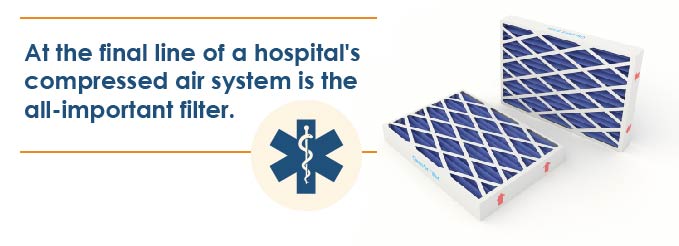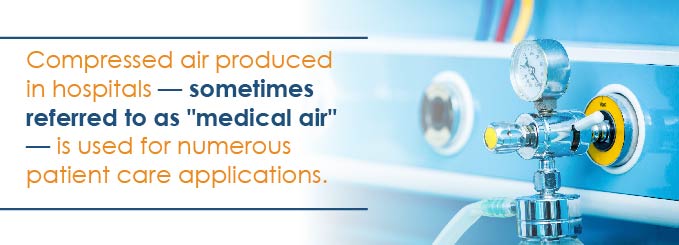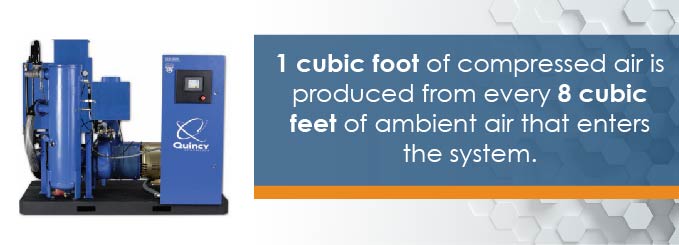
Hospitals rely on air compressors for a whole host of functions that range from facility operation to patient care. As such, compressed air systems often account for a sizable chunk of a hospital’s overhead. Understandably, saving money on compressed air in hospitals has become a primary goal among system operators who wish to cut down on overhead costs and pass those savings onto patients, all the while delivering optimal care with maximum power efficiency. However, in order to achieve significant hospital air system savings, it’s important to understand three basic factors:
- The uses of compressed air in hospitals
- The pieces that make up compressed air systems in hospitals
- The elements that damage compressed air systems
When the pieces of the system are properly fitted, maintained and protected from damaging elements, a hospital can save money, conserve power and boost efficiency with compressed air.
Contact Us Learn More Find a Dealer Near You
Pure Air for Sensitive Patients
In contrast to the various piped gases that are supplied in cylinders to medical facilities, the production of compressed medical air is generally done on the premises of hospitals. Due to strict sanitation standards, hospital compressed air systems must be put together and overseen with great care to ensure that germs and bacteria don’t enter the air that patients breathe or rely on for high-stakes medical procedures.
The majority of doctors who perform anesthesia are largely unfamiliar with the technical complexities that make it possible for compressed air systems in hospitals to deliver pure and sanitary air. However, the compressed air produced in hospitals — sometimes referred to as “medical air” — is used for numerous patient care applications. Medical air can be sourced from cylinder banks that funnel compressed air, but today’s hospitals primarily rely on compressor systems.
For patients with high levels of sensitivity toward the toxicity of oxygen, medical air serves as a purified alternative that allows them to undergo treatment and recuperate with less risk of exposure to undesired elements. Patients that fall within this category generally include anyone suffering from respiratory deficiencies, whether brought on by smoking or medical ailments. Newborns are also highly sensitive to toxicity, and therefore need to experience their first breaths of life with the cleanest air possible. For patients who are under anesthesia, compressed medical air serves as a safer, healthier, and eco-friendlier replacement for nitrous oxide.
Compressed Air Systems in Hospitals: Piece by Piece
Intake pipes
In hospitals large and small, the processes of a compressor system all begin at the intake pipe, where ambient air is first sucked into the machinery. At most hospitals, the intake is situated somewhere on the rooftop. For maximum purity, an intake should be located at least 10 feet from any other opening into the hospital building, such as doors, windows and other pipes. In terms of height, an intake should be situated no less than 20 feet from ground level. Intakes should be pointed downward and covered with screens to prevent the entry of rodents or water. The screen should be made of rustproof metal or similar material that won’t corrode over time.
Multi-system piping
If a hospital has two or more compressor systems, the pipes for each can be joined at a single intake pipe. Nonetheless, each pipe must be equipped with a close-off mechanism for situations where the corresponding compressor is removed for repairs or replacement. This way, the pipes are protected from air that could enter into each system from the mechanical room. For all intents and purposes, the rooftop intake must be labeled as the medical air source.
Environmental factors
Granted, the quality of outside air can vary according to the location of a hospital, as well as environmental factors within the surrounding community. While above ground atmospheric air is generally the cleanest, unnatural levels of pollutants might be present if construction crews or highways are situated nearby. The presence of factories, densely populated urban neighborhoods and energy plants can also affect air quality within a local area. Consequently, some hospitals located in or near such environments forgo the rooftop intake model and instead source air from indoors.
Indoor/outdoor comparisons
In hospitals that do opt for the indoor alternative, the intake must be operable around the clock, 24/7, and checked regularly for sanitation. As factors in a surrounding environment can and do change, comparisons should be made on an ongoing basis between the quality of indoor and outdoor air. That way, a hospital can determine whether it’s still in the best interest of patients to maintain one intake model over the other.
Cubic air
Through a series of processes that occur within an air compressor, one cubic foot of compressed air is produced from every eight cubic feet of ambient air that enters the system. While this happens, elements that might enter into the system along with the air — such as dirt, dust, moisture, oil and carbon monoxide — are concentrated and released through pneumatic tools and machinery along with the compressed air. Therefore, air compressors must be equipped with filtration devices in order to keep impurity levels as low as possible.
Backup compressors
Due to the non-stop nature of operations in the medical world, every hospital must have more than one compressor, even though only one machine might be active at any given time. The reason for this is simple: if one compressor breaks down or needs to be shut down for repairs, another machine must be there to serve as a backup. This way, the hospital never lacks an ongoing supply of fresh medical air. Alternately, each compressor within a system can be simultaneously activated during parts of the day. This can prolong the life of each machine by splitting workloads from one compressor to another, thereby leading to less wear and tear on any given machine.
Multiplex systems
At the heart of every compressed air system that operates inside a hospital is the multiplex setup consisting of two or more compressors. If a hospital is spread out in size or overwhelmed in the number of patients it treats, a system comprised of three or more compressors might make for an even more ideal setup. These larger systems are often referred to as triplex (three compressors) and quadraplex (four compressors).
Valves
Within the multiplex system, each compressor must have the capacity for handling air supplies at peak levels. Ideally, each compressor should be equipped with the following valves:
- An isolation valve
- A pressure-relief valve
- A discharge-line check valve
When maintenance is needed on one unit or another, the machine in question must be segregated from the system with a discharge shutoff valve. Likewise, the interconnecting shaft should be constantly inspected for the possible buildup of oil or other impurities that could degrade the quality of medical air.
Delivery
Once the air has been compressed within the multiplex system, medical air is sent to its final destination: hospital patients. Medical air is delivered through the following devices:
- Blenders
- Flowmeters
- Ventilators (for patients in intensive care)
Additionally, medical air is administered through pneumatic tools that doctors and dentists use while operating on patients. Medical air is not to be confused with the compressed air that might be used for non-medical functions within a hospital, such as the opening of doors and the movement of conveyor belts.
Receivers
Within a big system of two or more air compressors, large amounts of air get compressed at any given moment. For storage purposes, compressors are equipped with receivers, which hold compressed air until it’s needed among patients and hospital staff. For optimal performance, a receiver should be comprised of stainless steel and equipped with the following features:
- Relief valve
- Water trap
- Pressure gauge
- Auto drain
For servicing purposes, a reliever should also feature a three-valve bypass.
Dryers
Depending on outdoor temperatures, the ambient air that enters a hospital’s compressed air system through the rooftop intake is often dense with moisture content. In an air compressor, this translates to water buildup, which is bad news for any type of machinery. To combat the presence of water, an air compressor needs to be equipped with a drying component.
Refrigerants vs. Desiccants
In most systems, dryers are either of the refrigerant or desiccant variety. Refrigerant dryers separate air from water and drain out the latter. Desiccant dryers, on the other hand, absorb moisture from water. However, desiccant particulates can infect medical air with impurities unless the system is filtered regularly. Desiccant dryers also cost twice as much to operate and maintain. Therefore, refrigerant dryers are the obvious choice for operators intent on saving money on compressed air in hospitals.
Filters

At the final line of a hospital’s compressed air system is the all-important filter, which blocks oils and other impurities from entering the now-readied air. The filter prevents the following kinds of intrusions:
- Hydrocarbon leakage from oil seals
- Overflow from stuffed filters
- Corrosion flow from a receiver
For maximum reliability, final-line filtration devices should come with visual indicators. This way, operators can determine the level of contaminants that try to enter the medical air during any given period. A filter should undergo a full inspection at least every four months.
Piping types
Due to the threat of moisture and other elements, the piping contained throughout a medical air system must be non-corrosive. Therefore, the best type of piping for a hospital’s air system is copper. Other materials, such as iron and galvanized steel, can oxidize, which leads to particulates that flake and head downstream. This can ultimately cause interruptions with a range of medical air devices, such as blenders, ventilators, and various other types of patient care equipment.
Common Enemies of Hospital Air System Savings
Water
Out of all the contaminants that can infect compressed air systems in hospitals, water is the most corrosive, common and costly. Aside from causing damage to pipes and receivers, water can also lead to corrosion and mold growth on patient care equipment. Most distressingly, water can pass through filters that are made to block out particulate residue from iron, steel and rust. As such, water in all its forms — airborne moisture, system condensation — leads to endless repair bills and constant setbacks for medical air systems.
Moisture
The most common culprit found in malfunctioning vaporizers is moisture, which can travel from machine tanks to tool tips via compressed air. Often, the damage will render such devices beyond repair. With anesthesia machines, a total refurbishment is generally required to make them operable again following moisture damage. When temperatures are low, condensation within system pipes can lead to freezing. As water degrades within an air compressor, bacteria takes its place. Water bacteria can ultimately send pathogens into the hospital environment.
System entry points
There are numerous ways that water can enter into hospital compressed air systems, but the following are the most common:
- Insufficient water removal due to ill-fitted, overused or incompatible air dryers
- Weak or worn-out aftercooler drains
- Faulty liquid ring components
Water might arrive at these parts in the form of moisture that would elude the naked eye, yet ultimately that moisture can cause the formation of small puddles and streams.
Oil
In the past, oil-based medical air compressors have been known to suffer system failure due to the corrosion of lubricant and the dispersal of oil into compressed air. When lubricant corrodes, machine parts have trouble moving and friction forms at the joints of internal components. In order to prevent these costly malfunctions, most hospitals have switched to oil-free air compressors, which are not prone to breakdowns stemming from oil-related issues.
Maintenance tests
Saving money on compressed air in hospitals takes vigilance. Before problems arise, they should be considered as possibilities and treated preemptively with as many as 20 different tests, which should be repeated at regular intervals and evaluated for patterns in system behavior. Simply put, when compressed air systems in hospitals aren’t safe or sanitary, they defeat the purpose of the medical establishment.
Quincy: Powering Hospital Compressed Air Systems of Every Size
In hospitals around the world, various procedures are powered by medical air systems. From anesthesia to dental work, air-powered tools make operations safer, faster and more comfortable. Thanks to the purity of compressed air systems in hospitals, patients are treated to the finest air possible while undergoing and recovering from surgeries. At hospitals of every size, the efficiency and cleanliness of compressed air is made possible by manufacturers like Quincy Compressor: America’s leading name in compressed air technology.
Since 1920, Quincy has led the way in the development of air compressors and related machinery for high-stakes, high-powered operations in various industries. In environments as diverse as factories, auto repair shops and hospitals, our compressors have powered the tools and machinery that make assembly lines faster, hard jobs easier and medical operations safer.
In recent decades, compressed air technology has grown in tandem with increased awareness of the effects that oil, moisture and other impurities have on the quality of medical air systems. This had led to a heightening of air system standards in hospitals throughout the United States and abroad. Throughout all these developments, Quincy has remained at the forefront of innovation and optimization in the design and production of air compressors for practically every use possible under the sun.
Around the clock and throughout the week, a hospital must have clean, compressed air for everything from patient care procedures to building functions. If you’re in the market for new compressors to replace or add to the air system at your facility, Quincy carries a vast range of air compressors in various shapes and sizes. To learn more about our inventory, click over to our sales and services page today.
Contact Us Learn More Find a Dealer Near You




